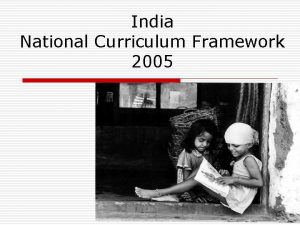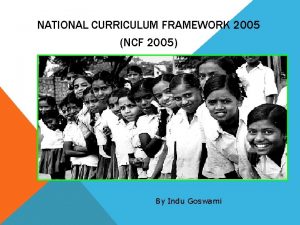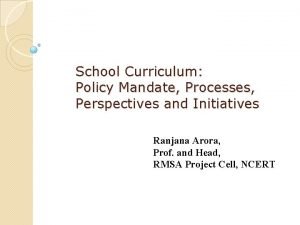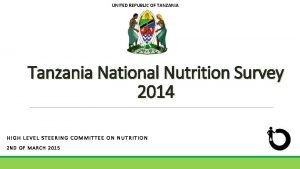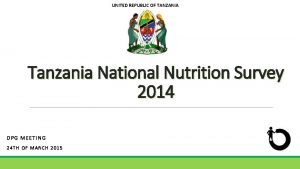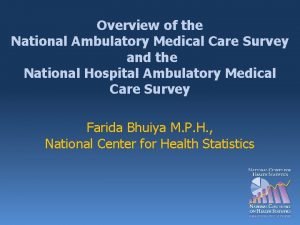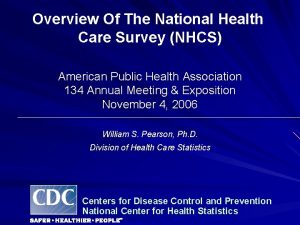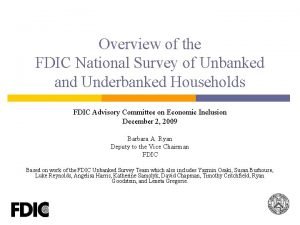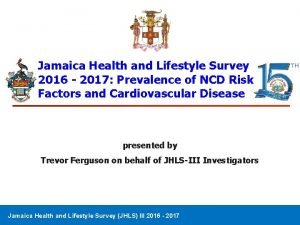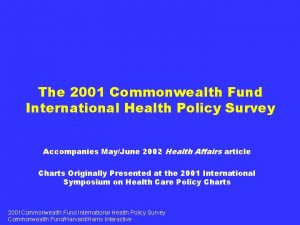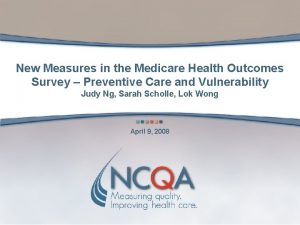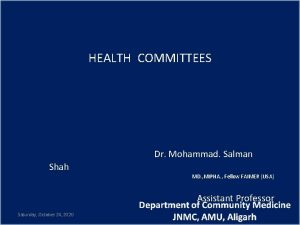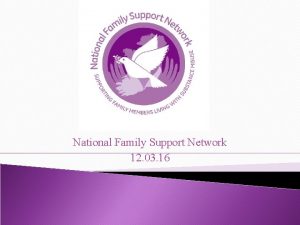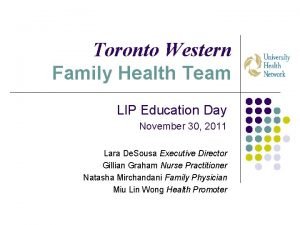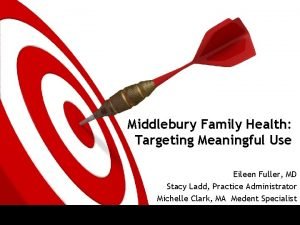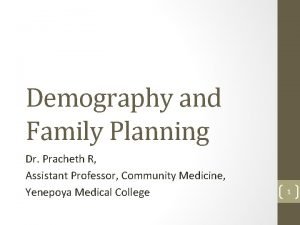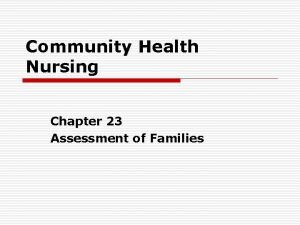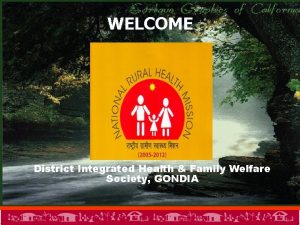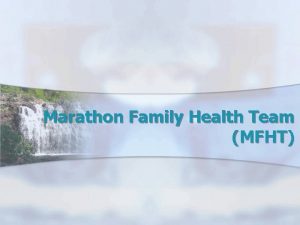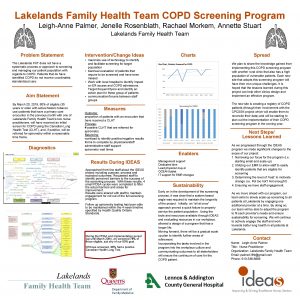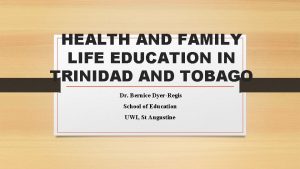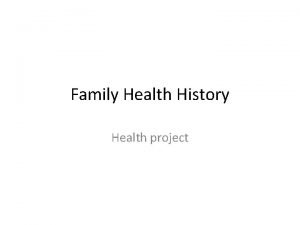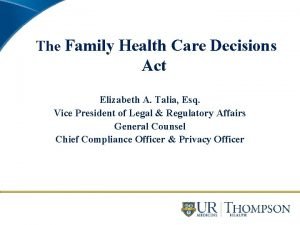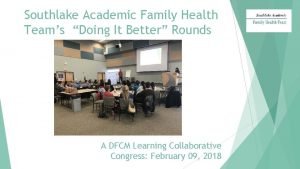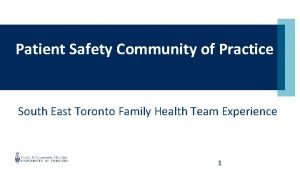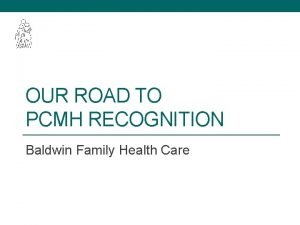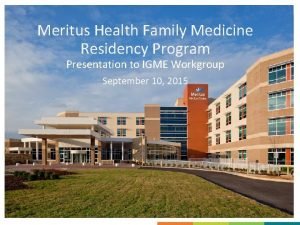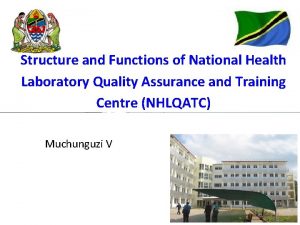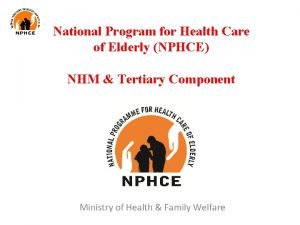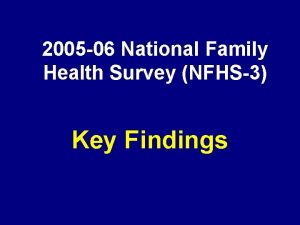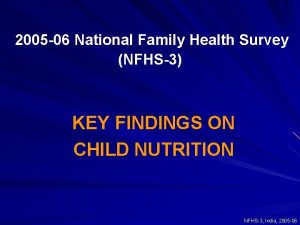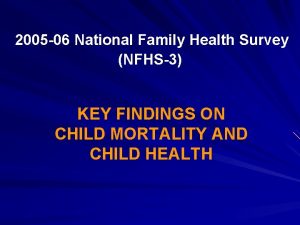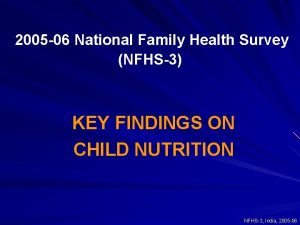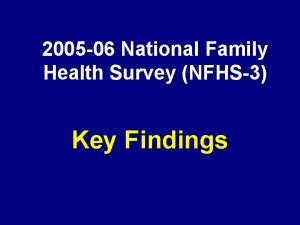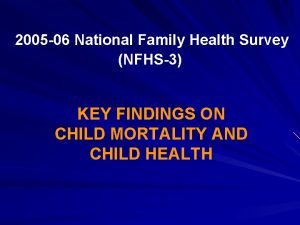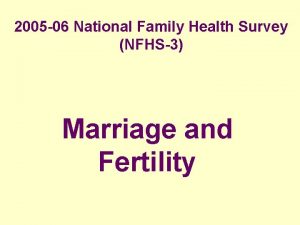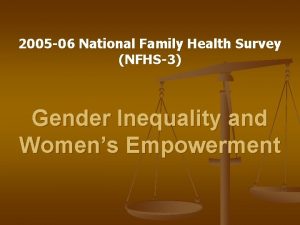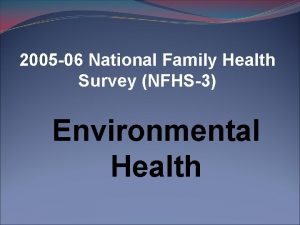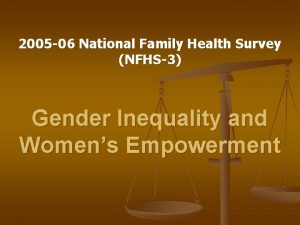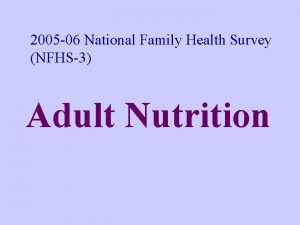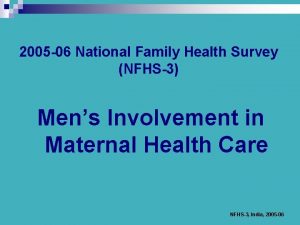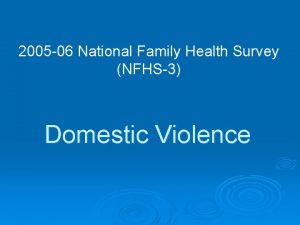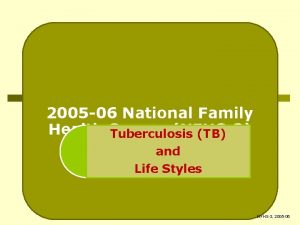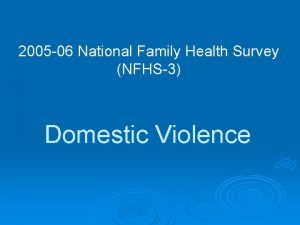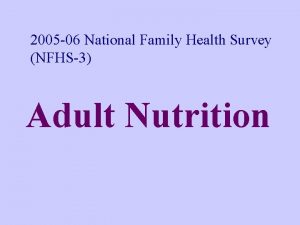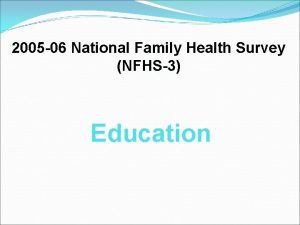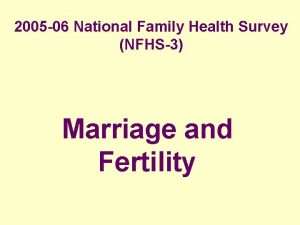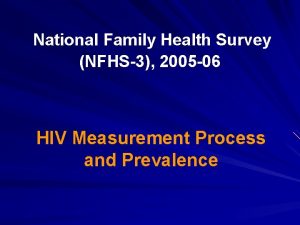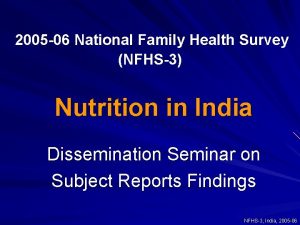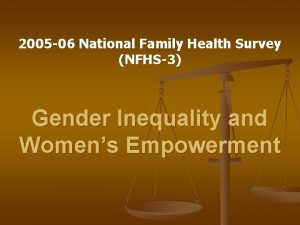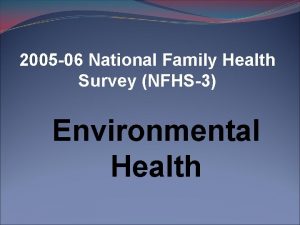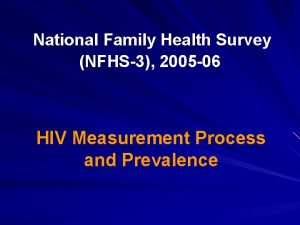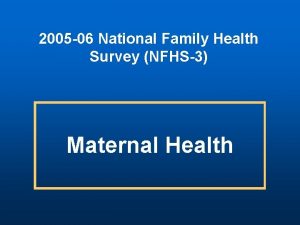2005 06 National Family Health Survey NFHS3 Key






















































- Slides: 54

2005 -06 National Family Health Survey (NFHS-3) Key Findings

Contents 1. About NFHS-3 2. Household and individual haracteristics 3. Fertility, marriage and family planning 4. Maternal health 5. Immunization and child health care 6. Nutritional status 7. HIV knowledge, behaviour and prevalence NFHS-3, India, 2005 -06

Overview v NFHS-3 is the third in the NFHS series of surveys, preceded by NFHS-1 in 1992 -93 and NFHS-2 in 1998 -99 v NFHS surveys are conducted under the stewardship of Mo. HFW v IIPS is the nodal agency for the National Family Health Surveys NFHS-3, India, 2005 -06

Contd. … v NFHS-3 is funded by USAID, DFID, the Bill and Melinda Gates Foundation, UNICEF, and UNFPA v Macro International provided technical assistance to NFHS-3 v NACO and NARI provided assistance for the HIV component v NFHS-3 fieldwork was carried out by 18 Research Organizations including some Population Research Centres NFHS-3, India, 2005 -06

Scope of NFHS-3 v All 29 states are covered v Slum and non-slum areas of eight cities, i. e. Chennai, Delhi, Hyderabad, Indore, Kolkata, Meerut, Mumbai, Nagpur v Interviews were conducted with Ø Women age 15 -49 Ø Men age 15 -54 NFHS-3, India, 2005 -06

Biomarkers Measured in NFHS-3 ü Height and weight ü Haemoglobin content in the blood to measure anaemia ü Collection of blood samples for HIV testing NFHS-3, India, 2005 -06

NFHS-3 Sample for 29 states Number Interviewed Response Rate Households 109, 041 97. 7 Women (age 15 -49) 124, 385 94. 5 Men (age 15 -54) 74, 369 87. 1 NFHS-3, India, 2005 -06

Contents 1. About NFHS-3 2. Household and Individual Characteristics 3. Fertility, Marriage and Family Planning 4. Maternal Health 5. Immunization and Child Health 6. Nutritional Status of Children and Adults 7. HIV Knowledge, Behaviour and Prevalence NFHS-3, India, 2005 -06

Selected Household Characteristics Percent of households NFHS-3, India, 2005 -06

NFHS-3 finds some improvements in the household environment since NFHS-2 68% of households have electricity, up from 60% in NFHS-2 88% of households use an improved source of drinking water Only 29% of households have improved toilet facilities NFHS-3, India, 2005 -06

Media Exposure 73% of urban households and 30% of rural households possess a TV NFHS-3, India, 2005 -06

Education NFHS-3 shows that even among those in the age group 15 -19, only 89% of men and 74% of women are literate NFHS-3, India, 2005 -06

Measuring Health Inequities NFHS-3 provides information on key population, health, and nutrition indicators for socially and economically vulnerable groups to examine health inequities – – – Caste/tribe status Wealth status Slum/non-slum population in eight cities NFHS-3, India, 2005 -06

What is the wealth index? Uses information on 33 household assets and housing characteristics, such as ownership of consumer items, type of dwelling, source of water, and availability of electricity Combines this information into a single wealth index, using a scientific method of assigning weights to individual components The household population is divided into five equal groups of 20% each (quintiles) at the national level from 1 (lowest, poorest) to 5 (highest, wealthiest) NFHS-3, India, 2005 -06

Caste/Tribe Status NFHS-3, India, 2005 -06

Distribution of Households by Wealth Index and Residence NFHS-3, India, 2005 -06

Distribution of Households by Wealth Index and Caste NFHS-3, India, 2005 -06

Proportion of Households in the Highest Two Wealth Quintiles by State NFHS-3, India, 2005 -06

Contents 1. About NFHS-3 2. Household and Individual Characteristics 3. Fertility, Marriage and Family Planning 4. Maternal Health 5. Immunization and Child Health 6. Nutritional Status of Children and Adults 7. HIV Knowledge, Behaviour and Prevalence NFHS-3, India, 2005 -06

Total Fertility Rate NFHS-3, India, 2005 -06

Marital Status Percent of women age 20 -24 married by age 18 NFHS-3, India, 2005 -06

Current Contraceptive Use by Method Percent of currently married women age 15 -49 NFHS-3, India, 2005 -06

Trends in Contraceptive Use by Method Percent of currently married women age 15 -49 NFHS-3, India, 2005 -06

Desire for No More Children among Women with 2 Children Percent NFHS-3, India, 2005 -06

Contents 1. About NFHS-3 2. Household and individual characteristics 3. Fertility, Marriage and Family Planning 4. Maternal health care 5. Immunization and child health care 6. Nutritional status of children and adults 7. HIV knowledge, behaviour and Prevalence NFHS-3, India, 2005 -06

Trends in Antenatal Care * For last births in the past 3 years NFHS-3, India, 2005 -06

Maternity Care (for most recent birth in the last 5 years) Percent NFHS-3, India, 2005 -06

Institutional Delivery NFHS-3, India, 2005 -06

Contents 1. About NFHS-3 2. Household and Individual characteristics 3. Fertility, Marriage and Family Planning 4. Maternal Health 5. Immunization and Child Health 6. Nutritional Status of Children and Adults 7. HIV Knowledge, Behaviour and Prevalence NFHS-3, India, 2005 -06

Infant Mortality Rate Deaths at age 0 -11 months per 1, 000 live births NFHS-3, India, 2005 -06

Infant Mortality Rates Deaths at age 0 -11 months per 1, 000 live births NFHS-3, India, 2005 -06

Child Immunization Trends Percent of children age 12 -23 months vaccinated NFHS-3, India, 2005 -06

NFHS-3, India, 2005 -06

Trends in Treatment of Childhood Diarrhoea with ORS Percent of children under age 3 with diarrhoea in the past 2 weeks NFHS-3, India, 2005 -06

Percentage of Children with Diarrhoea in the Past 2 Weeks who Received Any ORT or Increased Fluids by State NFHS-3, India, 2005 -06

Contents 1. About NFHS-3 2. Household and individual characteristics 3. Fertility and its determinants 4. Maternal health care 5. Immunization and child health care 6. Nutritional status of children and adults 7. HIV knowledge, behaviour and Prevalence NFHS-3, India, 2005 -06

Trends in Child Nutritional Status Percent of children age under 3 years (Low-height-for-age) (Low-weight-for-height) (Low-weight-for- age) NFHS-3, India, 2005 -06

NFHS-3, India, 2005 -06

Anaemia among Children Percent of children 6 -35 months with anaemia NFHS-3, India, 2005 -06

How Many Children Receive Services from an AWC? Percent of age-eligible children in areas with an AWC NFHS-3, India, 2005 -06

Nutritional Status of Adults Percent of women and men age 15 -49 NFHS-3, India, 2005 -06

Malnutrition of Women by Residence and Education Percent of women age 15 -49 NFHS-3, India, 2005 -06

Malnutrition of Men by Residence and Education Percent of men age 15 -49 NFHS-3, India, 2005 -06

Contents 1. About NFHS-3 2. Household and individual characteristics 3. Fertility, Marriage and Family Planning 4. Maternal health care 5. Immunization and child health care 6. Nutritional status of children and adults 7. HIV knowledge, behaviour and prevalence NFHS-3, India, 2005 -06

AIDS Awareness Percent of women and men age 15 -49 who have heard of AIDS Women Men NFHS-3, India, 2005 -06

Most Adults Support Family Life Education in Schools 63% women and 81% men think that information about HIV/AIDS should be taught in schools to both boys and girls More than 40% of women and 60% of men are in favour of teaching both boys and girls about sexual behaviour and condom use to avoid sexually transmitted diseases Adults are less likely to favour teaching about contraception than about HIV/AIDS NFHS-3, India, 2005 -06

Coverage of HIV Testing in NFHS-3 • Percent of eligible women age 15 -49 and men age 15 -54 whose blood was tested for HIV Women: 85 percent • Men: 78 percent • • Response rates are comparable to HIV test response rates on national household surveys worldwide NFHS-3, India, 2005 -06

HIV Prevalence HIV prevalence estimates are based on HIV tests of 102, 946 blood samples: 52, 853 from de facto women age 15 -49 + 50, 093 from de facto men age 15 -54 NFHS-3, India, 2005 -06

HIV Prevalence by Residence and Sex, India Sex Urban Rural India Women (%) Men (%) Total (%) HIV prevalence rate is 60% higher 0. 29 0. 41 among males than females and 40% higher in urban areas than rural areas 0. 35 0. 18 0. 32 0. 25 0. 22 0. 36 0. 28 NFHS-3, India, 2005 -06

Summary and Highlights Substantial improvements have been seen in child survival Fertility continues to decline – Urban women have already reached replacement level fertility, but rural women even now have an average of three children For the first time more than half of currently married women are using a contraceptive method NFHS-3, India, 2005 -06

Summary and Highlights (contd. ) There is steady decline in the proportion of women age 20 -24 marrying before the legal minimum age of marriage There have been improvements in antenatal care, institutional deliveries, and assistance at delivery by a health professional, but the changes over time have been slow Immunization coverage for children has improved for all vaccines except DPT NFHS-3, India, 2005 -06

Summary and Highlights (contd. ) Full immunization coverage has not changed much in the last 7 years Undernutrition and anaemia among children remain major challenges Adults suffer a dual burden of undernutrition and overnutrition NFHS-3, India, 2005 -06

Summary and Highlights (contd. ) HIV prevalence among the NFHS-3 household population of men and women age 15 -49 is 0. 28 percent. Based on this estimate and other data, the Government of India has reduced its official HIV estimate for the adult population. However, strong programmes are still required to prevent the further spread of HIV. NFHS-3, India, 2005 -06

Thank you… And now, on to the rest of the NFHS-3 National Dissemination Seminar! NFHS-3, India, 2005 -06
 Acls secondary survey
Acls secondary survey National curriculum framework 2005
National curriculum framework 2005 National knowledge commission conclusion
National knowledge commission conclusion Introduction of ncf 2005
Introduction of ncf 2005 Evaluation of ncf 2005
Evaluation of ncf 2005 National programmes related to nutrition
National programmes related to nutrition Amc 8 2005
Amc 8 2005 Key partners in business model canvas
Key partners in business model canvas Key partners key activities key resources
Key partners key activities key resources Tanzania national nutrition survey 2019
Tanzania national nutrition survey 2019 Tanzania national nutrition survey 2018
Tanzania national nutrition survey 2018 National hospital ambulatory medical care survey
National hospital ambulatory medical care survey National readership survey
National readership survey Noaa cors map
Noaa cors map National hospital care survey
National hospital care survey National survey of unbanked and underbanked households
National survey of unbanked and underbanked households National soil survey center
National soil survey center Singapore national nutrition survey
Singapore national nutrition survey Jamaica health and lifestyle survey 2019
Jamaica health and lifestyle survey 2019 Ehis eurostat
Ehis eurostat California health information survey
California health information survey Commonwealth fund international health policy survey
Commonwealth fund international health policy survey Medicare health outcomes survey
Medicare health outcomes survey European health literacy survey
European health literacy survey Mipha in medical
Mipha in medical Difference between nuclear family and joint family
Difference between nuclear family and joint family Periodic table families
Periodic table families Binuclear family vs blended family
Binuclear family vs blended family The negro family the case for national action
The negro family the case for national action Family support network
Family support network National unification and the national state
National unification and the national state Fht twh
Fht twh Middlebury family health
Middlebury family health Objective of family health care
Objective of family health care Family and community health advisor
Family and community health advisor Health aspects of family planning
Health aspects of family planning Family care plan in community health nursing
Family care plan in community health nursing District integrated health and family welfare society
District integrated health and family welfare society The marathon family
The marathon family Lakelands family health team
Lakelands family health team Define family life education
Define family life education Importance of family health
Importance of family health Family health optima
Family health optima Duke family medicine and community health
Duke family medicine and community health Family health project
Family health project Family health care decisions act
Family health care decisions act Southlake family health team
Southlake family health team South east toronto fht
South east toronto fht Baldwin family health care
Baldwin family health care Meritus medical center family medicine residency
Meritus medical center family medicine residency National health laboratory tanzania
National health laboratory tanzania National programme for health care of the elderly (nphce)
National programme for health care of the elderly (nphce) National policy and legislation related to child health
National policy and legislation related to child health Existanxe
Existanxe National core standards checklists
National core standards checklists

